|
|
|
|
Digital to analog converter
|
|
Jundac Two
|
Last revision on July 2010
|
|
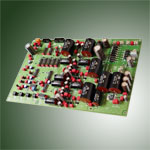 Click here for more pictures
Click here for more pictures
|
- Non oversampling DAC
- 24 bit DAC resolution (PCM1704)
- Open loop I/V converter
- Semi parallel regulator
- Low filtered output
- Optional external clock for very low jitter
- Low noise regulators (13x)
- Bipolar low noise solid states (MPSA18)
- Four digital input
- High toroidal power transformer
- Three power transformer
- Small capacitors power supply (300µF)
|
|
About design
|
The Jundac Two is a high-end 24bit non-oversampling digital to analog converter.
It integrates four S/PDIF or AES/EBU and stereo fixed analog output.
A non oversampling DAC don't use any digital filter. Data coming from CD are directly converted to
analog; there is no coloratura introduced by digital filtering, noise shaping or dithering.
Before output, the signal is smoothed by a sweet first order low pass filter.
To reach best listening quality, it can be coupled to an external low jitter clock.
When designing high quality device, each stage is important:
- digital (with or without digital filter),
- DAC chip,
- i/v stage,
- low pass filtering,
- regulators,
- power supply (transformers),
- passive components and wiring,
- grounding and link to earth,
- drawing PCB,
- chassis and mechanical vibrations.
You must care about each detail, everything is important. Digital filter is important in global
quality, but each stage is as important.
Relative audio quality level

To obtain best sounding, ensure to power on 48 hours before listening.
|
|
Technical documentation
|
|
|
Technical description
|
|
|
The Jundac Two use Cirrus CS8416, 32K to 192KHz DIR
(digital interface receiver) chip. The CS8416 provides digital de-emphasis needed for reading some CD
recorded with pre-emphasis and four inputs. Each input can be RCA, BNC or XLR with 75 or 110 Ohm.
Jundac Two can run in master or slave mode if an external clock is active.
Before DAC, digital data are re-clocked to avoid digital delay and reduce jitter and noise.
The DAC chips are PCM1704, K grade from TI Burr-Brown allowing 24bit resolution.
For convenience, analog output can be digitally inverted.
|
|
Schematic
|
|
|
The data stream feed a Burr-Brown PCM1704 24 bit DAC chip followed by feedback
free I/V stage with very sweet low pass filter. The low pass filter is first order filter cutting
at 30KHz using polypropylene film and foil capacitor. The MPSA18 were chosen for their high quality sounding,
each transistor are matched.
The Jundac Two uses very low noise regulators:
- LT1763 for the digital section (digital decoder),
- LT3080 for analog and DAC stage.
The analog section use seven very low noise regulator LT3080 form Linear Technology in a semi-parallel configuration.
|
|
|
In a semi-parallel regulator, i3 is adjusted to never become negative. Thus, the analog stage is never
directly powered by the regulator, this improve transient response. The LT3080 ensure line regulation.
Pictures of analog signal:
|
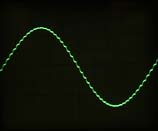
Low filtered output signal
|
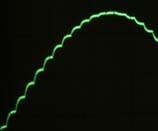
Detail
|
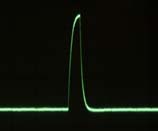
Dirac impulse response
|
|
|
Power supplies
|
Power supplies in a DAC are critical to the overall design. The Jundac Two uses thirteen very low
noise regulators: six for the analog section and seven for digital section. These power supplies
use polypropylene capacitors and three separate power transformers. For electrolytic capacitors, Elna Silmic II is used.
|
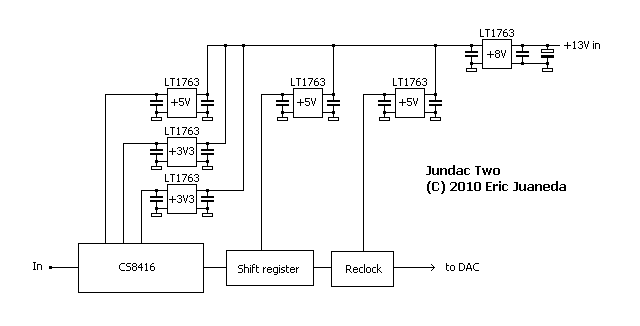 Detail of digital power supply
Detail of digital power supply
|
There is six LT1763 for digital section in a cascaded configuration (+8V, +5V, +3.3V). A dedicated regulator provides
regulation for re-clocking stage. The schematic is similar to the Digital decoder pro.
|
|
|



